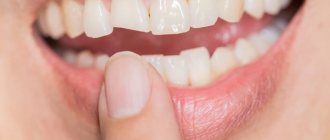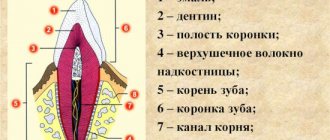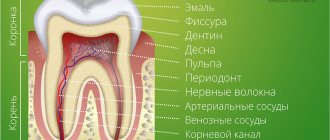Anatomy of permanent teeth
The molar tooth includes three zones: the root, which sits deep in the jaw socket and holds the tooth in place, the neck, located in the periodontal area, and the crown, which extends directly into the oral cavity. After the apex of the tooth appears, a protective film forms on the enamel, the strongest layer of the tooth, which is soon replaced by a salivary layer, formed from the saliva itself. The dental tissues themselves are not just a piece of bone, but a certain heterogeneity, which includes, in addition to enamel, dentin (the main substance of the tooth) and the dental cavity, in which nerves and blood vessels branch. Compared to bones, for example, the phalanges of the fingers, dentin is noticeably stronger - it contains an increased amount of minerals, for example, the same calcium-based compounds. The root zone of dentin is connected to the periodontium using a special layer - dental cement, which communicates with the tissues of the periodontium itself and supplies the dentin with nutrients.
Baby teeth in children: loss pattern
We have already said that the loss of baby teeth is associated with the growth of the jaws and the growth of the rudiments of permanent teeth. The rudiments of permanent teeth are located close to the roots of primary teeth, and therefore their development leads to pressure on the roots of temporary teeth (24stoma.ru). This pressure leads to resorption (resorption) of the roots of baby teeth, and as a result – to their mobility and loss. The exception is permanent molars (6-7 teeth), the eruption of which occurs without the loss of temporary teeth, and therefore parents often miss their appearance.
But sometimes permanent teeth erupt incorrectly, and this leads to the fact that the roots of temporary teeth may not undergo resorption for a long time. This situation is especially common in the area of eruption of permanent premolars (4-5 teeth), less often in the area of incisors and canines. In diagram No. 2 you can see the average time frame for when baby teeth change in children. An interesting fact is that in girls, tooth loss begins earlier and progresses faster (compared to boys).
When baby teeth fall out in children: scheme No. 2
Do all baby teeth fall out in children? Please note that temporary teeth can remain in the oral cavity for a much longer time. The main factor causing the loss of a baby tooth is the pressure of the permanent tooth germ on the roots of the baby tooth. Therefore, in the absence of a permanent tooth germ, or its death due to inflammation at the roots of a baby tooth, temporary teeth can remain in the oral cavity much longer than normal. In this case, milk teeth can sometimes be found even in 30-year-old people.
Summary: at what age do baby teeth fall out - loss begins with the central incisors of the lower jaw at 6-7 years of age (in girls, reliably from 6 years of age). Then, at the age of 7-8 years, the central incisors of the upper jaw and the lateral incisors of the lower jaw fall out (and in girls this process reliably begins at the age of 7). If we talk about the age at which milk teeth fall out, then usually this process ends at 12-13 years with the loss of the last milk teeth (second temporary molars).
When you compare the tables for the loss of baby teeth and the eruption of permanent teeth, confusion may arise in your head regarding the name of the teeth. For example, first and second temporary molars and first and second permanent molars. Please note that in place of the fallen first and second temporary molars, permanent premolars (4-5 permanent dentition teeth) will erupt.
Differences between baby teeth and permanent teeth
The structure of primary and permanent teeth is generally the same, but there are several noticeable differences. Which are better not to neglect:
Baby teeth have whiter enamel, while permanent teeth have a slight yellowish tint. Milk teeth are not as strong as permanent teeth due to the lower percentage of mineral substances. The pulp of baby teeth is wider and thicker, while dentin and enamel are, on the contrary, thinner. This explains the facilitated, spontaneous removal of a shelf tooth - there are often situations when schoolchildren in class independently loosen and remove milk teeth that have served their purpose. In permanent teeth, the length is significantly greater, dominating over their width and cross-sectional area. The root of a baby tooth is thinner and shorter - a person is able to pull out a baby tooth without the help of specialists. Meanwhile, the permanent “embryo” of a real tooth under the shelf one is already ready to grow quickly and be born. The latter is achieved due to the dental gap, which has expanded by the time the non-permanent tooth falls out.
Where do teeth come from?
Teeth are formed in the fetus’s body during the mother’s pregnancy. When a mother abused something and undermined her own health, the subsequently born child was guaranteed to have diseased teeth that were no longer permanent. At the 15th week of pregnancy, the mother has hardened dental tissues in the fetus - starting from the crown area and ending with the root zone. The embryos of molar teeth are formed by the 5th month of fetal life. The body of a developing fetus and child is designed in such a way that in the upper jaw the anlage of the permanent teeth is located above the anlage of the milk teeth, and in the lower jaw - vice versa. The formation and development of teeth begins as early as the sixth week of fetal development. The source for them is a special epithelial dental plate. Already by 14 weeks of pregnancy, the unborn baby is actively forming hard dental tissues, initially in the area of the coronal part, and then in the area of the roots of the tooth. When a child is born, primary teeth are the first to grow - by the end of the child's first year of life, they will erupt. However, the dentition contains a group of large molars - they, in turn, do not have milk predecessors and subsequently, when they fall out, grow “on a permanent basis”. Nature has arranged it in such a way that while the child’s jaws are still too small, large molars are not needed there.
What is missing in a child’s mouth: let’s figure it out
As we have already found out above, a person has molars and milk teeth in different numbers. The difference is that children do not have molars or otherwise “sixes” and “sevens” in their bite, as well as wisdom teeth, which are called “eights” and “third molars.” Molars appear as the jaw grows and expands and does not have milk predecessors - they erupt around 13-14 years. Third molars also have no predecessors, but can emerge at any age - at 20, 30, 40 and even 60 years. Or they may not appear at all.
On a note! In adults, from 1 to 4 third molars may grow, or none may erupt at all, which is the norm these days, since they are considered rudiments. This explains why the number of teeth in the permanent dentition varies from 28 to 32. But often the “sages” cause problems for the owners, since they come out incompletely, in the wrong place and in the wrong way, and ultimately destroy neighboring units and contribute to the development of infectious and inflammatory processes. And then it is recommended to delete them.
How many primary and molar teeth does a person have?
In children, the size of the jaw is almost half (in terms of the number of teeth that fit on it) smaller than in adults. Initially, the child has up to 20 teeth - 10 on each jaw. That is, one jaw - 4 incisors, 2 canines and 4 molars. Primary molars have not yet been clearly divided into small and large.
After 16 years, a teenager’s jaws reach approximate sizes that are accessible to an adult. A teenager already has approximately 28-30 teeth, and not 20-24, as before. The number of molars is often represented by 2 small molars and 2 large molars - on each side on each jaw. The last 2 or 4 teeth - “wisdom teeth” usually appear by the age of 20-22 - and a person acquires a full set of teeth, numbering 8 incisors, 4 canines, 8 small molars and 12 large molars - on both jaws in total.
Molars, their types
Immediately after the fangs there are 2 small molars - premolars. The structure of these teeth has its own characteristics: premolars generally have one root, consisting of two canals. Also, on the closure surface, they have only two tubercles. The crown shape is spherical. They are mainly involved in tearing and cutting food.
The second type of root teeth is called large - these are molars. They are located last in the dentition. Their total number is 12 (6 each on top and bottom). Three molars on the left and three on the right on each jaw. The third molar is the wisdom tooth. It appears later than the other molars.
Large molars perform the task of grinding food.
Therefore, they have a more complex structure. The shape of the molar crown resembles a cube. On the surface, the teeth have a wide closure area and three or four cusps. Large molars, which are located on the upper jaw, have basically four root canals, and lower molars have three canals.
What does the dental formula look like?
The medical record, which the big one keeps in the dental clinic at his place of residence, contains notes about his dental condition. To avoid confusion, doctors number the teeth on each side of each jaw. So, the 1st and 2nd teeth are incisors, the 3rd are canines, the 4th and 5th are small molars (doctors call molars molars), the 6th and 7th are large molars. The 8th - the farthest one - is a “wisdom tooth”; a number of people do not have it, or they do, but not all. Each side of the jaw is also numbered: 1 - top right, 2 - top left, 3 - bottom left, 4 - bottom right. For example, entry 48 does not mean that you are a “Tarkatan” with a combat superset of teeth that does not exist. You simply do not have a “wisdom tooth” on the lower right. Entry 41 - a person lost one of the frontal incisors on the same side on the same jaw. You can write down the formula of the teeth more clearly: for example, “there is no 8th tooth from the bottom right.”
It often turns out that due to lack of space on the jaw, the wisdom tooth develops incorrectly - it can grow crooked, in which case its removal is indicated. For example, it may remain under the gum and, because of this, be affected by caries, which can subsequently develop into pulpitis or a dental cyst. Problematic “wisdom teeth” are quickly and decisively removed, and their absence will not greatly affect the quality of chewing food.
Teething order
The timing of the appearance of permanent teeth to replace lost milk teeth is generally the same for all children and adolescents. After the child turns 5 years old, the first large molars make themselves felt. Then the central incisors are replaced from below, then the same teeth from above, and the lateral incisors from below. At 8-9 years of age, the lateral incisors on top are replaced. From 9 to 12 years of age, all small molars are replaced. At 13, all fangs are replaced. After 14 years, second large molars appear on all sides, which were not there before. By the age of 20-22, “wisdom teeth” finally appear. There are cases when during the rest of their lives they never erupted.
When does a child's molars come out?
Most parents are interested in the question: at what age do children’s molars begin to erupt? The first buds form in the fifth month of pregnancy. The exact timing of their appearance has not been determined and depends on the individual characteristics of the organism. Nevertheless, an approximate scheme for the eruption of molars in children exists. If the appearance of a permanent tooth is delayed for more than six months from the extreme threshold (especially after the loss of a baby tooth), consult a specialist. The doctor will take control of the process and be able to identify complications.
How to determine that a child will soon have molars?
According to some of the signs, interdental intervals initially increase. This happens due to the growth of the jaw bones - the teeth begin to not fit tightly together, as happens in adults. Then the temporary teeth gradually become loose - due to the gradual disappearance of the temporary root, which can no longer reliably hold such a tooth, and itself is gradually pushed out of the soft and semi-soft tissues on the jaw. The loss of a temporary tooth is a clear sign that the permanent tooth is already growing in full force, and the top of its crown will soon push apart the gum tissue. The appearance of a new tooth is also accompanied by slight redness and swelling. If a child or teenager has a fever, their health has worsened, and their gums hurt, go to the doctor immediately.
How and when do teeth change?
Loss of primary teeth begins at approximately 6-7 years of age and usually lasts until 10-12 years of age. Note that girls say goodbye to temporary teeth earlier than boys and the replacement process itself is more dynamic for them.
Parents will be able to guess that their child’s baby teeth are about to change due to a number of factors: due to jaw growth, the distance between the incisors will increase, the rudiments of molars become visible under the baby teeth, and the primary teeth become loose.
On average, the age at which a child changes teeth corresponds to the years given in the tables below:
Order of loss of baby teeth
| Age | What teeth fall out |
| 6-7 years | Central incisors fall out |
| 7-8 years | Lateral incisors fall out |
| 9-11 years | The child loses his first molars |
| 10-12 | Canines and second molars fall out |
⠀
Please note that the new tooth may not be in a hurry to take the place of the fallen one. If a couple of weeks or even more than a month have passed and there is still no molar, this is not a reason to panic. Also keep in mind that there are more molars, so some take their place without changing their predecessors. For example, molars or (the first permanent molars), erupt from scratch at the age of 5-7 years - they should not be confused with milk teeth.
Growth of molars
Molars are called a little differently than baby teeth. Try not to get confused:
| Molar | Age of appearance | Which milk tooth replaces |
| Central incisors | 6-8 years | Central incisors |
| Lateral incisors | 7-9 years | Lateral incisors |
| Fangs | 10-13 years | Fangs |
| First premolars | 9-12 years | First molar |
| Second premolars | 10-13 years | Second molar |
| First molars | 5-7 years | Do not replace baby teeth |
| Second molars | 11-14 years old | Do not replace baby teeth |
| Third molars | 17-25 years old | Do not replace baby teeth |
⠀
If you do not take into account the third molars (which are also called wisdom teeth), girls receive a fully formed jaw by 11-13 years, and boys by 13-14 years.
It is important to understand that the baby tooth may not be replaced. For example, if the germ of a molar tooth has died, then nothing pushes the temporary tooth to leave the mouth. People live with partial milk teeth even into their 30s. Therefore, if a baby tooth does not fall out, you should not try to loosen it or try to pull it out at home. Below we will look at other problems when changing teeth.
No molars
The molars, despite the specific timing specified above, may ultimately not hatch. For example, temporary teeth do not fall out for a long time, and permanent teeth do not grow for a long time after they fall out. At the first stage, the dentist will take an X-ray of the condition of the child or teenager’s jaws. The X-ray machine will clearly project what should grow in place of the supposed teeth, which teeth are ready to hatch, and whether they exist at all. But the problem will immediately become obvious, and the reason for it most likely lies in the physiology of the child, which has undergone some delay. If this is true, be patient: in the end, the teeth will not take long to arrive. But if the picture shows emptiness, you are faced with a complete absence of teeth, the reason for which is a violation of the intrauterine development of the fetus during the mother’s pregnancy. Only prosthetics will help here - artificial insertion of false teeth.
It doesn't hurt at all
Many parents put off their child’s meeting with the dentist for a completely obvious reason: adults have a fear of this office since childhood. But today dentistry is completely different. And a visit to the dentist becomes more of an exciting game for a child. In the doctor's office there are beautiful toys, sketchbooks, and favorite children's cartoons - the child can watch them even during the examination. In some clinics, the baby is allowed to “participate” in the treatment, for example, choose a filling of the color he likes.
ON A NOTE. In order for a child to never be afraid of the dentist, it is important to set it up correctly even before visiting the doctor. Never frighten a child with a dentist, do not mention your unsuccessful examples of visiting a doctor in front of your child, if you yourself are very worried, try not to show your emotions, children very easily feel the mood of their parents. Many children's dental clinics have specially designated areas for children's games; try to keep your child busy with games while waiting for their turn. If you have been prescribed a very long course of treatment, you can divide it into several stages so that the child does not get tired.
A child can remember the first feeling of pain in a dental office for the rest of his life. To prevent this from happening, doctors use local or general anesthesia and even pre-treat the injection site with an anesthetic spray or gel. Thus, dental treatment does not cause any unpleasant sensations in the child. To treat children's teeth, other instruments, materials and medications are used that are not used to treat permanent teeth. When choosing a pediatric dentist for your child, you can rely on reviews from other patients. In a good children's dental clinic, the rooms are equipped with the most modern technology, which allows you to treat children's teeth silently and painlessly.
If the disease is not advanced and caries has affected only the surface layer, the teeth are simply silvered - this is an old and well-tested method of treating teeth without a drill. But it has a significant drawback: the black silver salts that fall out during the reaction leave dark spots on the enamel. Therefore, silvering is currently giving way to remineralizing therapy. In this case, the teeth are coated with a special composition that saturates them with fluoride, closes the affected crystal lattice of the enamel and allows you to stop the process. The natural color of the enamel is not lost.
If the destruction goes deeper, a filling is placed. Treatment is carried out under general anesthesia. When the caries damage is so large that a simple filling cannot withstand the load, the doctor uses metal or plastic crowns as a temporary measure. Their main task is to preserve the baby tooth until it is replaced with a permanent one.
The saddest verdict of the dentist: the tooth needs to be removed. The measure is necessary in two cases: when the tooth is severely damaged or when the milk tooth goes out of the natural loss schedule and prevents the permanent tooth from erupting.
After removal, a special plate is installed under general anesthesia, which compensates for the defect in the dentition and prevents further deformation and malocclusion.
Of course, removing baby teeth is a last resort, as this can lead to serious problems. Firstly, to improper development and deformation of the jaw, which in the future is fraught with bite pathology. Secondly, the absence of a tooth disrupts the process of chewing food and diction. Timely prevention and proper dental care will help you avoid serious problems. Therefore, it is recommended to show the baby to a specialist at least once every four months.
Molar tooth hurts
After the molar has emerged from the gums, the “young” tooth enamel is not fully saturated with all the necessary microelements. During this period, the tooth is especially vulnerable: it is strictly forbidden to subject it to overload. It is not for nothing that children are advised not to chew, for example, candy, large quantities of peanuts, or any solid foods. If you neglect this rule, children may immediately develop caries, and this is the path to problems with specific teeth. Caries gradually turns into pulpitis (damage to the internal cavity of the tooth) and periodontitis (damage to the ligaments surrounding the tooth). The child often experiences toothache and poor general health. Without turning to a professional doctor for help in time, parents can lead their child to various consequences - up to the complete loss of a diseased tooth. If a predisposition to the appearance of carious lesions has been identified, their prevention may involve closing the natural deep pockets surrounding the molars. This is done using high-quality composite materials. In this case, food debris will not accumulate in these places, destructive microflora will not develop, and the period of susceptibility to caries will pass when the teenager grows up.
Molars grow crooked
Molars are also subject to crooked growth. They can begin to actively grow before the temporary ones become loose and fall out. Encountering this natural obstacle in the process of their growth, they can grow crookedly than would be intended by nature - they are “led” to the side. If the growth of a molar is detected immediately after a temporary one, this defect leads to a curvature of the bite, which is why the child or teenager will need the help of an orthodontist. In this case, it is necessary to urgently remove the temporary tooth that is interfering with the growth of the permanent one. If time has not yet been lost, it may be possible in this way to remove the predisposition of the same tooth to acquired curvature. Despite the fact that a teenager, having realized the uselessness of a temporary tooth, can independently loosen it and remove it, doctors strongly advise refraining from such a step so that the child avoids, for example, sepsis.
General overview
The rudiments of the first molars are formed in the womb, and eruption occurs after birth. As a rule, this happens along with the child's first activity. Teething often causes anxiety in the baby, fever, and swelling of the gums.
By the age of two, a child will have grown all of its baby teeth. They differ from the indigenous ones in their smaller size and different shape. Milk units can be recognized by their characteristic bluish tint. Indigenous ones have a yellowish or grayish tint.
The process of replacing the first units with indigenous ones begins at the age of 6. Both teeth require proper care. A proper diet, regular hygiene measures and scheduled visits to the dentist are fundamental factors that contribute to the development of a normal bite and the growth of healthy teeth.
By the age of 6 years, a child develops 12 molars (6 on each jaw). The upper molars are large and quite strong. These are three-root units that take on the main loads when chewing and biting food. Molars grow in place of lost milk teeth. But there are exceptions. A molar can begin to actively grow even in the presence of its predecessor. This is accompanied by pain and discomfort. In such a situation, it is recommended to visit a dentist.
Molars fall out
If molars suddenly begin to fall out suddenly, this is a sign that the child’s health is not in the best condition. Tooth loss is preceded by both systemic diseases (immune problems, impaired development of connective tissue) and local ones (caries, pulpitis, periodontal disease, etc.). Tooth from permanent dentition. When lost, it leaves behind a permanent problem. A radical solution could be a complete insertion of an artificial tooth - but... Before it is carried out, the child will have to use a removable and replaceable prosthesis before he grows up.
Injuries
An accident or incident, such as a fight, can cause a tooth injury. And it doesn’t matter whether a small part has broken off, or the tooth has cracked, as they say, “to the point of bleeding” - the help of a doctor is definitely needed. In some cases, lost dental tissue is replenished. If a tooth is broken into pieces, it will most likely need to be completely removed and a prosthesis replaced every year. And the answer is simple - the dental tissues have not yet fully matured, the body is growing. And it is necessary to take full care of your teeth at such an early age. In case of extension, the operation is performed by introducing composite materials that replace enamel and dentin.
What is important to pay close attention to
We looked at the main difference between baby teeth and permanent teeth. We found out that the latter are stronger and more durable due to their structural features. However, it is important to understand that the permanent units that have just erupted (the change of incisors occurs at approximately the age of 5-9 years, canines - 9-13 years, premolars - by 12-14 years) are not yet sufficiently mineralized. That is, they do not have the necessary strength. Their final mineralization occurs within the next two years after eruption.
Expert opinion
Tatyana Vitalievna Varlamova
Specializations: Dentist-therapist
Experience: 7+
“Many parents still think that baby teeth do not need treatment and prosthetics if they have been subjected to dental pathologies. All hope is that soon the child will have a permanent bite, in which the enamel and dentin are very strong. But it is important to know that the well-being and safety of the dairy crop also depends on the health of the dairy crop. Early removal of temporary elements and damage to their roots affects the rudiments of permanent elements and leads to developmental anomalies.”
Therefore, the teeth of children aged 7 to 15 years need especially careful care, strengthening, and control by parents and dentists. That is, they seem to be already permanent, but at first they are still very weak, which is why they are easily susceptible to caries and other dental pathologies.











